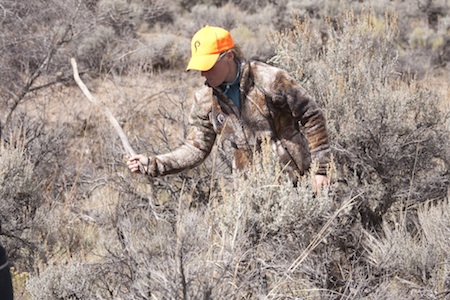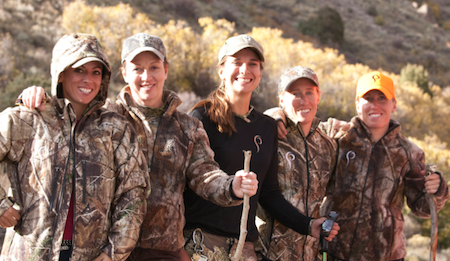Babbs in the Woods
The sport of falconry, long regarded as the sport of kings, only allows two royals to participate – the falconer and the raptor. The rest of us were peons, peasants, dogs, aka bush beaters. Women’s Outdoor News’ writers Mia Anstine, Lanny Barnes, Tracy Barnes, Katherine Grand and I enjoyed an afternoon of following falconers in western Colorado near Gunnison.
Mary K. Wilson, in “Falconry: The Real Sport of Kings,” wrote, “The sport of falconry binds man and raptor into an intimate dance of life and death.”
When The WON went a’hunting in western Colorado, we watched in fascination as two falconers and their birds took us to the dance. Of course, as we described earlier, we had to beat a few bushes in order to watch a Red-tailed hawk named Karma and a Northern goshawk named Nova in action.
Our falconers, Deanna Curtis and Roger Tucker, spent the day not only hunting and handling the birds, but also answering many questions we had for them about the sport of falconry. Curtis is the executive director of Wild Wings Environmental Education, a nonprofit education organization in Centennial, Colo. Its primary goal is to foster a greater public awareness of the important roles that Colorado’s native birds and bats play in the environment.
Tucker explained, “Nine times out of ten, the birds miss because the game knows how to escape a falcon. It’s when you combine the dog, the human mind and the dog, it works out real well.” He then instructed the beaters in etiquette of the hunt: to stay even or behind the falconer, who controls the hunt.
Go on the hunt with us, through photos taken by Jason Baird.
This ain’t her first time at the dance, and Karma – a Red-tailed hawk – looks at the photographer with a rather annoyed expression on her face. Her falconer, Deanna Curtis, probably is explaining to the group of brush-beaters what is expected of them. “Don’t swing your arms and walk calmly through, beating the bushes as you go.” Said fellow Falconer Roger Tucker, “That’s why they call it ‘bushwhacking!’” Meanwhile, Karma waits patiently, because she knows what she will do. Already fitted with a tracking device, Karma is ready to rock and roll on a bunny or two.
Notice falconer Deanna Curtis’s vest with huge pockets that contain rabbit meat, a homemade lure with a feeder mouse on it, a receiver for the tracking device on her bird, plastic bags for game caught, a flask with high-dollar Patrón XO Café in case game is caught (to honor the tradition of the kill in the field by the bird, or a “fantastic flight”) and a whistle to call the bird back to the lure. Curtis said, “If I’m calling her back to the fist, I just whistle [by mouth]. If she’s going one direction and there’s an eagle coming at her, or if she’s headed for a power line with a transformer on it, and I use my whistle, she’ll come back to me because she will get the mouse.”

Olympic biathlete Lanny Barnes beats the bushes for bunnies for Karma. Photo courtesy of Jason Baird
Perfect posture for sticking her landing, Karma heads for a rock pile so that she can watch her handler and the bush beaters. She wears a bell, so that her falconer and the beaters can hear her. In the old days, before tracking devices, falconers would hang two or three bells on their birds.
Wilson, the wonder dog, knew the routine and worked hard at searching the sagebrush for a bunny for Karma. Upland bird dogs, like Wilson (a Brittany), work extremely well with falconers.
Karma sees and starts her final approach toward the bunny. We could hear her in motion, as she also wears a bell.
Karma mantles over her prey, a cottontail rabbit. Said Curtis, “Here she is mantling her prey; therefore other predators will not see her. She covers it up. I usually call her off right away, because the more I let her eat on a kill, the more possessive she gets and the harder she is to train off. In fact, she will immediately hop off the prey when she sees the lure.” For leaving the rabbit, Karma gets a reward – the dead feeder mouse.” The falconer then stretches the game and breaks its neck.
Falconer Roger Tucker introduces his Northern goshawk, Nova, to the group. Falconers keep hoods on their birds, mostly for the birds’ safety. Tucker says raptors get distracted and distressed while traveling in cages, perhaps in a vehicle with windows, and want to fly to other birds they see along the way. Nova is in her fourth year of hunting.
Originally, royalty flew falcons and the cook flew a goshawk. According to Tucker, with the invention of guns, the sport of falconry declined. It became popular again in this country in the 1950s and 1960s. It is the most regulated form of hunting, at state and federal levels. Tucker says Americans are topnotch falconers because of their innovations – new techniques and styles of flying these birds, captive breeding resulting in hybridized birds (“mutt-falcons, if you will”) and telemetry, the use of radio-tracking devices that allows the falconer to let the bird fly in a freer style.
Falconer Roger Tucker moves toward his bird, Nova. Notice his ski pole that he uses to whack bushes. He says Colorado is a Mecca for used-ski poles in thrift shops!
Female hawks usually are about a third larger than their male counterparts, so they can hunt rooster pheasants, mallard ducks and jackrabbits.

Mia Anstine, Barb Baird, Katherine Grand, Lanny and Tracy Barnes — all wearing Prois Hunting Apparel. Photo courtesy of Jason Baird
Tucker said falconers like to trap juvenile birds; it is legal only to trap passage or eyass birds (chicks), called passage birds, that have been pushed from the nest. “If a bird makes it through the first year … usually there is a 60-70 percent mortality rate … falconers will trap a bird in the fall, train it, hunt it and release it in the spring. They go wild so quickly, even after a few years.” According to Tucker, once released, the birds never look back. “They go wild real fast.”
Teamwork in play here, as Nova steps back and does not mantle while Tucker stretches the cottontail, breaks its neck and then allows Nova a bite and a treat of rabbit meat that he brought along. He tucks the prey into his back pocket vest, and took the rabbit home. No part of the rabbit will be wasted; all will either be fed to the raptors or used as training bait.
Please visit Wild Wings Environmental Education.
This Retro WON piece was first published on Dec. 29, 2012.
Publisher/Editor Barbara Baird is a freelance writer in hunting, shooting and outdoor markets. Her bylines are found at several top hunting and shooting publications. She also is a travel writer, and you can follow her at https://www.ozarkian.com. View all posts by Barbara Baird
Thanks, Lisa. Good to hear from you and thanks for reading The WON! i can imagine you with a raptor on your arm, in fact. It takes guts, I believe.
I have been increasingly fascinated by falconry over the past few years. I cannot wait for the day that I can witness a hunt in person. There is something so majestic about the sport that leaves me wanting to learn more.
What a great job you and Jason did explaining the hunt. I was fortunate enough to “wear the glove” at the instruction of a Falconer in upstate New York about 25 years ago. The weight of a huge hawk landing on your hand to eat a bit of rabbit is a remarkable feeling. I can only imagine what it’s like on a “real” hunt like you experienced. Thanks for the thorough coverage. It’s very inspiring.